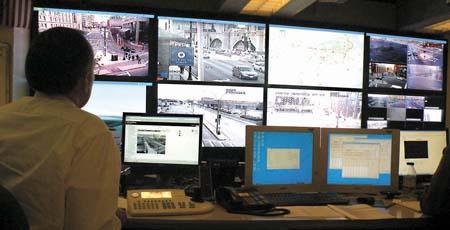December 15, 2011

Traffic flow in various sections of the city is monitored by technicians using an array of cameras in a windowless room on the seventh floor of City Hall.
It might come as a surprise, but one of the most impressive views of Boston can be found in a dim, windowless room on the seventh floor of City Hall.
From his station here in the city’s Traffic Management Center, a technician watches a dozen flat screen televisions displaying live feeds of major intersections from the Back Bay to Franklin Park, part of a growing network of more than 100 traffic cameras installed along busy roadways.
On Monday, as the Reporter observed during a visit, one supervisor received word of a stalled car near the Museum of Science. He called up a live shot to get a closer look. Then, with a few keystrokes, the traffic lights changed. Soon, the dozen or so motorists stacked up at the snarled intersection were back on the move.
This command center atop Government Center, operated by the Boston Transportation Department (BTD), has most of its “eyes” trained on downtown trouble spots. But, thanks to an investment of federal stimulus funds, Dorchester’s notoriously backed-up main thoroughfare— Dorchester Avenue — will soon be the second road in the neighborhood to come under direct BTD supervision. Columbia Road is already monitored by 17 cameras.
Drivers still have a few months before they can expect similar services on Dot Avenue. But city officials say new traffic patterns, curb cuts, and networked signals being installed as part of the ongoing renovation work on the avenue will cut down on congestion for both cars and pedestrians at a total of 15 key intersections.
The $14 million Dot Ave. Project, funded through the American Reinvestment and Recovery Act, is expected to be complete by the spring of 2012. But BTD’s senior transportation manager Patrick Hoey said his engineers are already seeing improved travel times along Dot Ave., despite recent complaints from some residents that turns they once took off the avenue have been eliminated.
Barring any unexpected delays, Hoey said the revised traffic signal patterns are expected to prevent the majority of traffic snarls on Dot Ave. and that the networked camera system will give BTD the ability to tweak lights in the event of any slowdowns.
Hoey said the decision to eliminate certain turning options, like the ability for southbound drivers to turn right onto Adams Street in Fields Corner or left hand turns off Freeport Street onto the avenue in Glover’s Corner, stem from rush hour observations that indicated that the relatively small number of drivers taking this turns were disproportionately slowing traffic.
In the case of Fields Corner, Hoey says, only 40 cars made the eliminated turn onto Adams Street during peak hours, accounting for 4 percent of southbound traffic. Meanwhile, Hoey noted that traffic in Glovers Corner is predictable enough that stop and go signals are possible, rather than flashing yellow as they did when drivers had more turning options.
“It’s an inconvenience for a small number of people,” Hoey said. “But we feel that small inconveniences like that are worth what you pick up, to give back a couple of seconds [to other drivers.]”
BTD director of policy and planning Vineet Gupta said that while synchronizing traffic signals along the avenue is expected to help speed up commutes, some of the biggest gains are expected to come from shifting crosswalks and “bumping out” sidewalk corners at the cost of parking spaces. Gupta said the diagonal angles at which many streets cross the avenue created inviting, though turn-hindering, parking spaces that engineers determined added to rush hour congestion.
Hoey said that while BTD has received some complaints from area drivers and business owners over lost parking spaces, the additional sidewalk space creates an opportunity for future Brown Foundation-funded art projects similar to the statues currently in place at Edward Everett Square. He said the new art spaces, as well as recently-installed crosswalk patterns and uniformed light fixture styles were meant to underline a sense of visual continuity as people make their way down the avenue.
“There’s all these diverse neighborhoods that Dorchester Avenue connects and we wanted to create an identity that ties all of these diverse communities together,” Hoey said. “We want to identify Dorchester Avenue, to capture the uniqueness of the corridor itself.”
Villages:
Topics:


